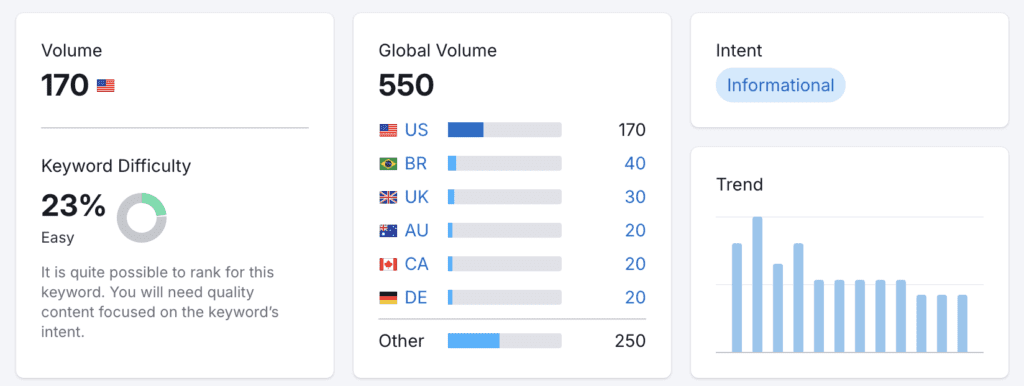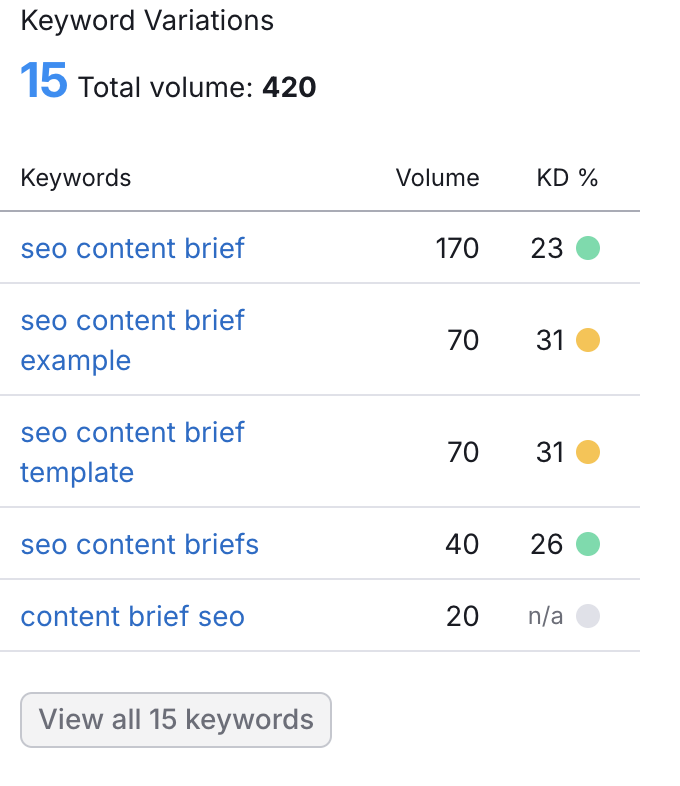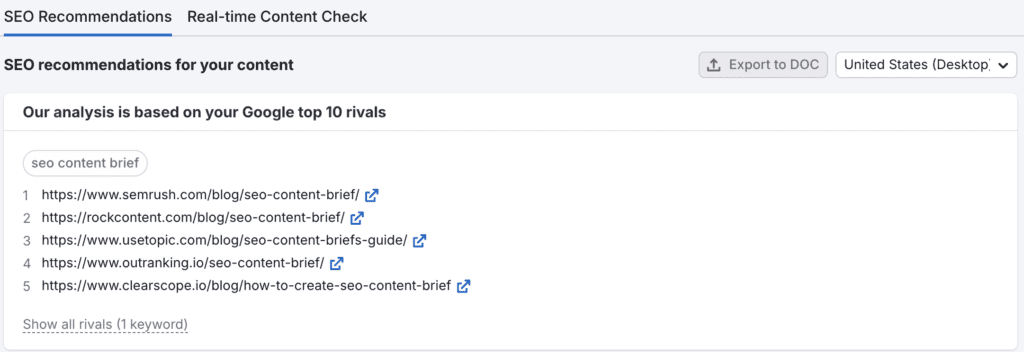Ever find yourself staring at a blank page, wondering how to start an article that needs to rank on Google? That’s how I felt before starting this article. So I made an SEO content brief to help accelerate the process. How meta is that?
An SEO content brief is your roadmap to content creation. It provides clear, concise directions for your content writers, ensuring everyone’s on the same page. It’s not just about keywords—it’s about aligning the writer’s work with SEO goals and brand voice.
Let’s break down what goes into a good SEO content brief and why it matters. I’ll also share my example of content brief that I made for this article. Use it as a template if you want.
What is an SEO Content Brief?
An SEO content brief is a guide created to help writers understand the goals for a specific piece of content. It includes important details like keywords, search intent, word count, competitive analysis, target audience, etc.
The main goal of an SEO content brief is to ensure that the marketing team and freelance writers know what’s expected, making it easier to deliver quality content the first time around. It’s a blueprint for creating high-quality content that search engines want to kiss.
What’s Included in an SEO Brief?
Great content briefs give writers the details they need to create top-notch content. Here’s what you should include:
- Primary keyword: The main keyword you want to rank for.
- Secondary keywords: Related phrases and variations of the primary keyword.
- Expected word count: How long the article should be, based on the topic and competitor content.
- Target audience: The people you want to reach with your content.
- Solution: Why is your audience searching for this article?
- Purpose: Why does your audience need this article?
- Brand voice: The style and tone that match your brand.
- Internal links: Links to other relevant pages on your site.
- External links: References to credible external sources.
- Competitor links: High-ranking articles from competitors for reference.
- Headings: Main sections and subtopics to organize the content.
- Technical details: Guidelines for headlines, meta descriptions, and other SEO elements.
- Call to action: What you want readers to do after reading the article.
Including these elements helps writers understand the project and reduces the need for revisions. This ensures a smoother content creation process and timely publishing. A clear brief means your content team will get just how you like it the first time around.
Don’t worry, I’ll go more in-depth on these SEO content brief elements later in the article.
Why SEO Content Briefs Matter
Solid SEO content just makes life easier for everyone – writers, editors, and your marketing team. I don’t know about you, but I like to make things easy.
Beyond improving workflow, SEO briefs offer other benefits…
- Better Rankings: Content aligned with SEO best practices is more likely to rank higher and attract more traffic.
- Enhanced Performance: High-quality content that meets user needs and Google’s criteria can boost CTR and drive more organic traffic.
- Consistent Style and Tone: Writers can maintain a consistent brand voice and style, ensuring all content feels cohesive.
- Target Audience Connection: A good brief connects the topic with the target audience, addressing their specific needs and questions.
- Fewer Edits and Revisions: With clear guidelines, writers produce content that’s closer to the mark, reducing the need for extensive edits and rewrites.
- Hit Deadlines: With a clear SEO content brief, errors are reduced, and the content creation process is streamlined. This means faster turnaround on drafts, helping you hit those all-important delivery deadlines.
- Fewer Production Costs: Fewer edits and revisions not only save time but it saves money too.
How to Construct Your SEO Content Brief
At this point, you should understand what an SEO brief is and why it’s important. Now it’s time to dive in the how-to.
Let’s expand on some key elements of an SEO content brief I mentioned earlier. This will help you construct your own.
Primary Keyword
Keywords are the foundation of SEO. Your primary keyword is what Michael Jordan was to the 90s Bulls. It’s the main term you want your content to rank for. It’s the term that should show up in your headlines, subheadlines, body, URL slug, and meta description. It’s your star player.
The primary keyword for this article is “SEO content brief.” Here’s the overview for this keyword according to SEMrush:

Secondary Keywords
While the primary keyword – like the star player – gets all the glory. You can’t rack up wins without a solid supporting cast. Secondary keywords are you’re supporting cast.
Secondary keywords are related terms that provide additional context and help your content cover more ground. Including them in your brief ensures your content is thorough and covers all relevant topics.
Here’s what secondary keywords do:
- Avoid keyword stuffing: Using secondary terms naturally in your content prevents overusing the same keyword.
- User intent: While primary keywords focus on the main topic, secondary keywords address subtopics, questions, or variations of what users might search for.
- Targeted traffic: Secondary keywords often include long-tail keywords, bringing in more specific and highly targeted traffic.
- Better content: Since secondary keywords cover my subtopics and questions it also helps make content more impactful.
Here are some examples of some secondary keywords for “SEO content brief:”

Expected Word Count
To make sure your article fully covers a topic, it’s important to aim for the right word count. One way to figure out the expected word count is by checking out what your top competitors are doing. See how long their articles are for the keywords you’re targeting.
I use SEMrush’s “SEO Content Template” for word count. It gives you a rough idea of how long your article should be to compete with the top pages. But take that number with a grain of salt.
SEMrush is giving me a recommended text length of 1413 words for the keyword “SEO content brief.”

My approach is a bit different. First and foremost, I ask myself did I cover this topic thoroughly? If not, I’ll add more. At this point, I know I’m going to go over SEMrush’s recommended word count, and that’s just fine because what’s important is if the article is helpful to your audience.
Target Audience
Your writers need to know who they are writing for. That’s why you need to ask yourself – Whose our audience? Are they experts or amateurs? What problems are they trying to solve?
You should add the following details about your target audience when creating your SEO content brief:
- Pain points
- Typical reader
- Industry or niche
- How they benefit from your product or service
Remember, when you write for everyone you write for no one. That’s why you need to figure out who you are writing to. Google Analytics can help with this.
Solutions
Every search begins with a purpose. What does your audience want to know? By figuring this out and matching it to your target keywords, you can effectively address their needs.
Once you’ve identified what your audience is looking for, mention the solution early on, especially in the first few paragraphs. This way, your readers know immediately they’re in the right place.
I gave a simple explanation in the introduction of this article and then jumped into a section that further elaborated on what an SEO content brief is.
Make sure your writer understands we’re living in a TLDR world. If the reader can’t see any promise that your content will provide them with a solution within the first couple of sentences then they’ll click elsewhere.
Purpose
Always keep in mind why your audience needs your information. Communicating this to your writers and editors will help them stay on track.
For example, the purpose of this article is to help my audience have a better understanding of what constitutes an SEO content brief.
Brand Voice
Include details about your brand’s voice, tone, and style in every content brief. Create a basic style guide or provide links to past articles.
If the writer has a clear idea of your brand’s voice and tone they’re going to be able to communicate with your audience more effectively.
Sticking to the brand will also help you build trust and credibility with your audience.
Internal Links
Internal links help search engines navigate and understand your site, plus they keep visitors engaged longer, reducing your bounce rate.
Which internal links should you include?
- Relevant links within the context
- Links on similar or related topics
- Links to your products, services, or conversion pages
Identify relevant internal links and include them in your brief. That means providing them with both the URL and anchor text.
I’m going to use this opportunity to drop an internal link into this article by suggesting you read my SEO on-page checklist when you’re done with this article.
External Links
External links add credibility to your content. They show readers (and Google) that you’re referencing reliable sources. Include guidelines for selecting external sources and how to incorporate them.
Generally, you don’t want to link to competitors or low-quality sites. A lot of time statistics make the best external links. You also don’t want too many external links. One to two external links per 500 words is more than enough. Make sure to let your writer know this.
Competitor Links
Include top-ranking articles for your primary keyword in your content brief.
Your competitors can help writers understand why these articles rank well and how to create even better content to outrank them.
The goal is not to copy these articles. The goal is to mimic the strengths of the top-ranking articles to make one super article that will hopefully outrank them all. Make sure your content team understands this.
Once again, I use SEMrush’s “SEO Content Template” to research competitors. Here’s a look at my top competitors for this article:

Provide Outline
Provide your content team with an outline for your article that includes:
- title recommendation(s)
- meta description recommendation(s)
- headers (H1-H6s)
- keyword placement
- image alt text
- related articles
Call to Action
Every piece of content should drive action. Whether it’s signing up for a newsletter or making a purchase, your call to action (CTA) should be clear and compelling. Provide examples of effective CTAs to guide writers.
Here are a few examples:
- Buy now
- Free trials
- Read more
- Learn more
- Newsletter signup
- Share on social media
You get the idea.
Common Problems with SEO Content Briefs
Creating briefs can have a significant impact on your workflow. But it can also lead to some issues.
Let’s explore some common mistakes and how to avoid them…
Prioritizing Keywords over Solutions
It’s easy to get caught up in a keyword frenzy. However, focusing solely on keywords without considering solutions can backfire.
Overemphasis on keywords can make content feel robotic. Encourage writers to address what your audience is actually looking for. Always ask yourself – is this content helpful to my audience?
Blindly Trusting Keyword Tools
Keyword tools are great, but they’re not infallible. Cross-check suggestions for accuracy and relevance. A human touch can often spot nuances that tools miss.
Copy Cat Content
We want to mimic articles that Google likes but we also want to create original articles that provide our audience value. Be like Pablo Picasso. Know what it means to “steal like an artist.”
There’s nothing in this article about content briefs that hasn’t been said before. But it hasn’t been said like this before. Make sure your writer understands this nuance.
Time-Consuming
Creating briefs at scale can be a headache. Automation tools can streamline the process, making it more efficient. This allows you to maintain quality without getting bogged down.
Providing Optimization Suggestions After the Fact
Optimization should be part of the planning process, not an afterthought. Provide SEO suggestions before content creation to save time and improve quality.
Final Thoughts
An SEO content brief is your guide to creating effective, engaging content that ranks. By covering all the bases—keywords, audience, brand, and more—you set your team up for success.
Remember, a good brief is clear, concise, and actionable. Use these tips to create briefs that drive results and make your content shine.
Good luck with creating your next SEO content brief. I’ll provide an example of a stupidly simple SEO content brief I did for this article:
Also, if you found this article helpful make sure to share it with someone that would benefit from it. Happy SEOing yall.


